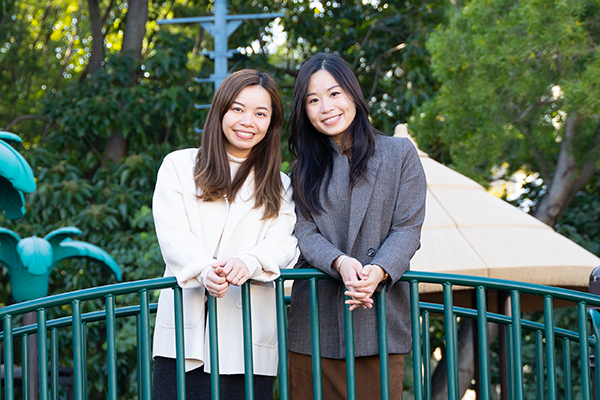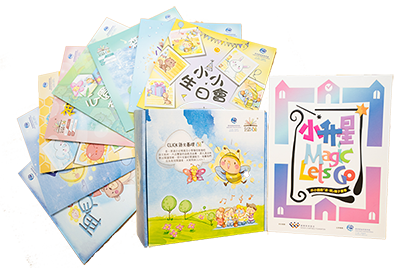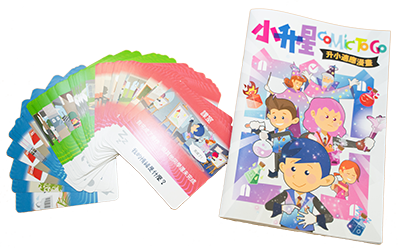CS Service:Hope in The Time of Pandemic - Technology-led Children Rehabilitation Service
Recently, there has been increasing advocacy for using technology to support children with special educational needs (SEN). Since the COVID-19 pandemic, we have been exploring how to incorporate technology into our Children Rehabilitation Service (CRS). As Sar Hiu Ching, Sa, the Unit Head-cum-Speech Therapist of our District-based Speech Therapy Service (DSTT), said, 'In the middle of difficulty lies opportunity. We discovered service gaps we could fill using technology during the pandemic.'

(Left)Sar Hiu Ching, Sa, the Unit Head-cum-Speech Therapist of our District-based Speech Therapy Service and
(Right) Lam Tsz Wai, Yuki, the Unit Head of Bridge-Integrated Education Service (Team 3)
SEN Training is Not One Size Fits All
The suspension of face-to-face classes during the pandemic brought significant challenges for speech therapy training. Sa pointed out that there is no recipe to follow in SEN training. One must rely on something other than words and worksheets to help parents and children understand the skill training. 'During the pandemic, we have realised that parents are unequipped to train their children at home. As for grandparents or helpers who are primary carers for the children, it’s even harder for them to understand our instructions.' The use of technology can be a great help here. Other than video calls, the need for interaction in video games can spark the children's interest and help therapists systemically teach parents and carers how to train their children.
Lam Tsz Wai, Yuki, the Unit Head of Bridge-Integrated Education Service (Team 3), said, 'we should not use technology to follow trends but to fill service gaps that appear due to changes in the environment. We need to use innovative and technological thinking to lead our services.' Yuki pointed out that society still views Early Education and Training Centre (EETC) as a stick-in-the-mud and training-based institution. But after three years of the pandemic, CRS has become more flexible and elastic.

Our professional team has developed a teaching kit with the aim of improving children's oral expression and comprehension,
as well as developing their basic reading abilities for primary school language learning.
Professional Colleagues Building AR Learning Materials
Taking students entering their first year of primary school as an example, they only had around 80 days of face-to-face classes in kindergarten during the pandemic. Their relationships with classmates are more like ‘internet friends,’ only ever having interactions through video calls. They lacked the experience of a social life offline. Sa said, 'SEN students need to learn many social-emotional skills. The pandemic has made adapting to the complicated and dynamic primary school life much more difficult.' To address these problems, the CRS developed 'Social & Emotional Support for P1 Adaption of SEN Students', sponsored by the Woven Charitable Foundation. With the collective expertise of social workers, speech therapists, educational psychologists, and special child care workers, 'Magic Let's Go' was published. This training kit includes a comic book, a board game, and an AR treasure hunt that are helpful for SEN students in facing difficulties in their primary school life.
'The training kit revolves around the theme of magic. We hope students can welcome their coming primary school life in relaxation and anticipation,' said Yuki. Students will first learn primary school life skills through comic strips. Then, they will 'preview' difficulties that may come up in campus life through the board game and rehearse ways to overcome them. Lastly, the AR treasure hunt will help them familiarise themselves with the campus.
Using Robotics to Alleviate Worker Shortage
'CRS is a dynamic team who can quickly respond to environmental change.' Yuki said that whenever they discover gaps in their service, they will brainstorm new ideas to fill the gaps. Yuki and Sa pointed out that technology not only addresses the needs of SEN students and their parents but also alleviates the problem of the shortage of professionals. Yuki shared with us her experiences participating in an international autism spectrum disorder conference in Singapore, 'the design of kindergartens and training centres in foreign countries surpassed my expectations and inspired me to start thinking about using robots to assist our trainers.'
She explained the long-standing problem of a therapist shortage in preschool rehabilitation services. The timely application of technology, using robots as assistants, can help mitigate the labour shortage. 'Robots can help SEN children learn different facial expressions and provide immediate translation for ethnic minority service users,' she said. After returning from the conference, Yuki collaborated with the Hong Kong Science and Technology Parks Corporation, connecting different tech companies to pair services with service users. With the expectation to improve EETC, they hope to build towards an intelligent centre. 'There are still many components in consideration. We aim to develop a smart centre that is visionary, sustainable, able to fit the needs of SEN students, and aids in making training more concrete.'

'Magic Let's Go' include comics, board games, and augmented reality to assist
SEN children in adapting to the different challenges they may encounter in primary school life.
Data Collection and Advocating for Sector to Use Innovation and Technology
Technology alleviates the worker shortage problem and helps trainers accumulate valuable experience. Last June, the CRS launched the 'VICTOR' – Early Childhood Professional Training Project, funded by the Community Chest's Social Innovation Fund. With the VR environments designed by the interdisciplinary efforts of nurses, psychologists, and social workers, synchronising with prop infants with built-in sensors, the workers can practise childcare methods. It provides a safe training environment for childcare workers.
Sa explained, 'taking epileptic infants as an example, the lifting and transfer techniques we use on them are different from those on normal infants. However, at the beginning of training, it wouldn't be wise for trainees to practise on infants with epilepsy. The utilisation of VR provides a safe environment for training.' She went on with the example of premature infants. Their hand muscles are weaker. Thus the methods of taking care of them are different. VR can give a detailed analysis of caring methods. 'This project is very innovative, which integrates therapists’ education into VR. The timely intervention of real-life training can improve the training outcome to save human resources.'
Yuki further pointed out that this VR project is a process of both verification and advocacy, 'In the past, CRS only provided in-person training from school to placement workshops. However, the costs would be extremely high under the shortage of human resources if we require therapists to participate in every training session. We anticipate that in this project, we will be able to collect data on the learning progress of trainees, carry out data analysis, and push the professionals to think about how to apply VR in the sector.'








